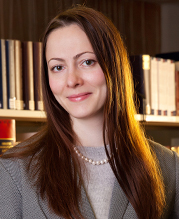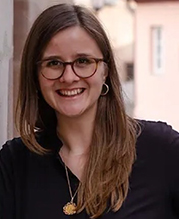7. August 2024 | Interviews
A comparison of the integration of Ukrainian refugees in European countries: “Sustainable integration has proven effective”

Comparing the various European countries, how wide is the gap in the employment rates of Ukrainian refugees?
Gatskova: There are significant variations in terms of refugee employment rates in Europe. And the pattern shifts over time, too. In the fourth quarter of 2022, more than 50 percent of Ukrainian refugees were employed in countries like the United Kingdom, the Netherlands and Lithuania. In other countries such as Norway, Romania, Switzerland and Spain, less than 15 percent were employed. Germany is in the mid-range in Europe, with the employment rate increasing from around 20 percent at the end of 2022 to just under 27 percent in the first quarter of 2024.
Gatskova: Germany is in the mid-range in Europe in terms of the employment rates among Ukrainian refugees.
What do countries with high employment rates do differently?

Dr Kseniia Gatskova is a senior researcher in the Research Department “Migration, Integration, and International Labour Studies” at the IAB.
Gatskova: We see high employment rates particularly in those countries that have so far focussed on temporary residence rather than long-term integration of refugees. In these countries, refugees are quickly placed in jobs with no special qualification requirements, and often subject to precarious conditions. They often only work a few hours a week, very often on short, fixed-term contracts, and their employment tends to be below their qualification level. For instance, the large number of people working in so-called on-the-call jobs contributes largely to the high employment rates in the Netherlands. In Denmark, the majority of employed refugees work in a cleaning sector.
Gatskova: In countries where Ukrainian refugees have high employment rates, they are often placed in precarious, low-skilled jobs.
So these countries have tended to pursue a “work first” strategy?
Gatskova: Exactly. By contrast, there are other countries that focus on long-term sustainability when it comes to labour market integration. These countries apply the “language first” approach: the idea here is that refugees learn the language and have their qualifications recognised first so that later on they can get jobs that correspond their qualifications. Previous research has shown that this approach creates more stable labour market trajectories in the long term and is beneficial to both the refugees and the host country. And it applies not only to work and income but also to the integration of refugees into society as a whole. Refugees who take language courses or do training courses are factually not available to the labour market during this period, or only to a limited extent. Accordingly, employment rates are relatively low in these countries in the initial period after arrival.
Are there other factors that account for the differences in employment rates?
Koch: Yes. For example, employment rates are higher in countries that offer a better childcare infrastructure. This is important for Ukrainian refugees in particular, because Ukrainian refugees are predominantly women with many of them having with children.
Another key factor is the situation on the labour market and how the latter is regulated. It’s more difficult to find employment in countries where unemployment rates are on the rise, for instance. As a lot of people find jobs through their friends and acquaintances, social networks are also crucial in terms of labour market integration. Refugee employment rates are higher on average in countries where there was a larger share of people with Ukrainian citizenship prior to 2022.
Koch: Employment rates are higher on average in countries that offer a better childcare infrastructure.

Dr Theresa Koch is a researcher in the research department “Migration, Integration and International Labor Market Research (INTER)” at the IAB.
How important are transfer payments?Koch: We looked into whether employment rates are higher in countries where there is a higher average level of expenditure per refugee as a proportion of per capita gross domestic product. But our analyses only showed a weak, non-significant correlation here.
What about the language barrier?
Koch: This is a key factor. Employment rates are higher in countries where the population as a whole has a better command of English.
Koch: The language barrier is a key factor.
How does Germany’s approach to integration fit into the overall picture?
Koch: In Germany, the focus is on sustainable integration of refugees. This includes language programmes, qualification programmes and targeted job placement. Germany has set itself the goal of integrating refugees as quickly as possible, but with a view to the long term. At the present time in particular, when there is a shortage of skilled labour, it’s crucial for people to be employed according to their qualifications. Ukrainians have an above-average level of education, and this is something Germany can tap into.
Isn’t the accelerated job placement programme “Job-Turbo” an implicit admission that the German approach has not worked so well so far?
Gatskova: Not at all! Policy-makers are indeed trying to accelerate the integration of refugees in the labour market through the “Job-Turbo” programme, but this doesn’t alter the basic principles of the sustainable strategy: first of all, everyone gets to complete the language course or training they require for employment and they’re supported by the state during this transitional phase.
Sustainable integration has proven effective over time. Eight years after their arrival, the employment rate among refugees who arrived in Germany between 2013 and 2019 is 68 percent. In contrast, the Netherlands and Denmark, who have adopted a different approach to integration, have much lower employment rates.
Gatskova: Employment rates among older refugee cohorts are much lower in Denmark and the Netherlands than in Germany.
How important is the demographic structure among the refugees themselves?
Gatskova: That’s a key point. Such factors as gender, age and family status are essential to understand potential challenges related to integration. Women are always disadvantaged in the labour market to a greater or lesser extent – and that applies virtually everywhere in the world. And it’s even more difficult for women with a migrant background to integrate into the labour market: in addition to the typical hurdles, they have to learn the language, acquire new knowledge about the host country and expand their social networks at their new place of residence.
The fact that women are at a disadvantage in the labour market has a lot to do with the unequal distribution of unpaid childcare and care work in families. So it’s hardly surprising that women have better prospects of finding work in countries with a better childcare infrastructure. This is borne out by our empirical findings, too.
To what extent is the demographic breakdown of Ukrainian refugees proving to be a problem?
Koch: The Ukrainian refugees are a very specific group because, as I mentioned, they frequently tend to be women, in particular mothers of underage children. As men of military age are generally not allowed to leave the country, many of these women are basically single parents in the destination countries. This means they’re dependent on state childcare and can only take up a job if childcare is guaranteed.
In addition, refugees are in an even more difficult situation than the usual migrant groups: people who’ve fled a war zone have often had traumatic experiences. This is another reason why it’s so important for these people to have access to healthcare. Good health is essential in order to get a job.
Koch: Good health is essential in order to get a job.
What is still the biggest challenge in terms of integrating Ukrainian refugees?
Gatskova: According to the results of survey, most refugees regard support in learning German as being the area of greatest need. The demand for childcare is very high among mothers with children who are of pre-school or primary school age. For refugees who have worked in regulated occupations, such as medical staff, getting qualifications recognised is a major challenge.
Koch: As things currently stand, Ukrainian refugees don’t have long-term residence status. Temporary protection is currently only guaranteed until 4 March 2026. This is a relatively short period of time – for both Ukrainian refugees and potential employers. Both jobseekers and companies need a long-term planning perspective. To this end, clear paths have to be identified for refugees to obtain a residence, work or settlement permit.
Gatskova: What is more, experimental studies from all over Europe – including Germany – indicate that there is discrimination in the recruitment of people with a migrant background. Whether or not integration is successful depends on more than just the refugees: it also depends on policymakers, the overall institutional framework and last but not least the local population, too. Integration is a process that involves all stakeholders.
Gatskova: Integration is a process that involves all stakeholders.
Ms Gatskova, you yourself are originally from Ukraine and you have friends who have fled to Germany and probably want to stay here. To what extent do these individuals’ personal experiences align with your research findings?
Gatskova: To some extent, I may have some advantage in researching the integration of Ukrainian refugees, since I can always compare the results of the data analysis with the real-life stories I hear from my friends and acquaintances. From the personal experience, I can certainly confirm that refugees have very high employment aspirations: I don’t know anyone who wants to remain unemployed for a long time. Most women from Ukraine previously worked, and they wish to continue to do so in Germany. Our survey data indicates that more than 90 percent of Ukrainian refugees want to take up a job in Germany, and this is confirmed by my own personal experience.
Many find it very difficult to learn German, however. Some take the language tests two or even three times in their effort to obtain the B1 or B2 certificate. In my experience, it takes about two years for a linguistically competent person to reach B2 level in German.
Can you give us specific examples from among the people you know of how well integration in the German labour market works?
As often in life, the overall picture is mixed. I know one Ukrainian refugee who was delighted to hear that she had been accepted onto a training course, enabling her to embark on a stable career in the insurance sector while continuing to learn German.
Another friend from Ukraine has two daughters to look after and works in a nursery home, while at the same time continuing to learn German and trying to get her medical qualifications recognised. Her biggest worry is that her earnings will not be enough to cover next year’s heating back payments. She’s wondering whether she can increase her working hours or perhaps soon get her qualification recognised so that she can switch to a better-paid position at a hospital.
I also know two highly qualified academics and mothers who have been actively looking for a job for months, but they haven’t even been invited to an interview yet.
The integration of Ukrainian refugees has been the subject of heated debate in German politics in recent weeks, with critics arguing that the labour market is not moving fast enough. What advice would you give German policymakers?
Koch: In addition to obtaining a solid legal status, refugees also need further support in learning German. In terms of integration policy, the question also arises as to whether language and integration courses should increasingly be offered on a part-time basis or whether more practical experience could be incorporated into the courses. In Norway, Ukrainian refugees can take a six to twelve-month part-time introductory programme: this enables them to work and do the programme at the same time. German integration courses should also be adapted more flexibly to meet people’s needs. Childcare could be included in the programme, for example, i.e. the children could be looked after while the parents are doing the course.
Koch: Language and integration courses should be offered on a part-time basis, too.
In addition, people who wish to stay in Germany could be supported in obtaining a school-leaving certificate or a vocational qualification. As soon as refugees obtain a qualification or have an existing qualification recognised, they should be given more support in finding suitable work. So job centres have a key role to play in the ongoing process, too. It would also be good to provide more benefits for companies that employ refugees. If children and young people can go to school and there are more childcare options for young children, this is good for social integration as well, ensuring that in the long term, refugees stay will stay in Germany for more extended periods of time.
Literature
Kosyakova, Yuliya; Gatskova, Kseniia; Koch, Theresa; Adunts, Davit; Braunfels, Joseph; Goßner, Laura; Konle-Seidl, Regina; Schwanhäuser, Silvia; Vandenhirtz, Marie (2024): Labour market integration of Ukrainian refugees: An international perspective. IAB Research Report No. 16.
Bild: weyo/stock.adobe.com
DOI: 10.48720/IAB.FOO.20240807.01
Keitel, Christiane ; Schludi, Martin; Winters, Jutta (2024): A comparison of the integration of Ukrainian refugees in European countries: “Sustainable integration has proven effective”, In: IAB-Forum 7th of August 2024, https://iab-forum.de/en/a-comparison-of-the-integration-of-ukrainian-refugees-in-european-countries-sustainable-integration-has-proven-effective/, Retrieved: 10th of December 2025
Diese Publikation ist unter folgender Creative-Commons-Lizenz veröffentlicht: Namensnennung – Weitergabe unter gleichen Bedingungen 4.0 International (CC BY-SA 4.0): https://creativecommons.org/licenses/by-sa/4.0/deed.de
Authors:
- Christiane Keitel
- Martin Schludi
- Jutta Winters

 Christiane Keitel is scientific editor in the department "Media and Communication" at the IAB.
Christiane Keitel is scientific editor in the department "Media and Communication" at the IAB.  Dr Martin Schludi is scientific editor in the department "Media and Communication" at the IAB.
Dr Martin Schludi is scientific editor in the department "Media and Communication" at the IAB. Jutta Winters is scientific editor in the department “Media and Communication” at the IAB.
Jutta Winters is scientific editor in the department “Media and Communication” at the IAB.